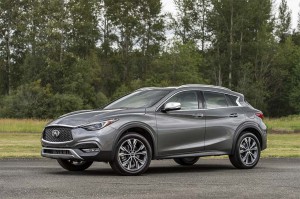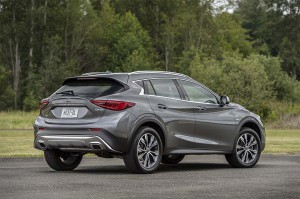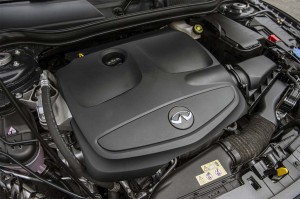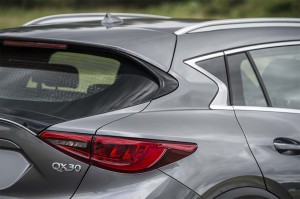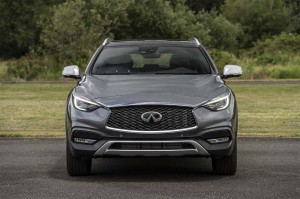It’s what you don’t see that often determines what you get. Platform sharing has taken place for years, and it oftentimes makes good fiscal sense within a company like General Motors. If you are fifity-ish or older, then you remember the 1970’s Chevy Monte Carlo, Pontiac Grand Prix, Buick Regal, and Oldsmobile Cutlass, all sharing trim and mechanicals.
Today, Ford and Lincoln share parts among their sedans and SUVs, as does Lexus with Toyota, and most of the many Volkswagen Group brands. Why build something new when you can keep the bean counters happy by dipping into the corporate parts bin?
But what is not always known is that manufacturers are more and more often sharing platforms and other technologies with major competitor. There’s the Mazda Miata MX-5 and te new Fiat 124 Spider, for example. And now comes the Infiniti QX30, which shares running gear with the Mercedes-Benz GLA 250.
(For more on what Daimler and Nissan are doing together, Click Here.)
When you first approach the 2017 QX30, you’ll be impressed with the styling. Externally, this luxe compact ute is all Infiniti, which means it’s gorgeous and well contented. Where the GLA takes no visual risks, Infiniti jumps into an Olympic sized pool with a deep breathing front fascia and sensuous side sculpting. QX30’s tall beltline makes this premium active crossover seem taller than it is, and Infiniti’s trademark, crescent-shaped “C” pillar lets buyers know the DNA is all Infiniti.
Nor is the interior a rubber stamp of the GLA. For example, the Mercedes telematics screen sits atop the central dash like a permanent iPad. Infiniti’s display is integrated into the central instrument panel, below the dash hood. It’s a coin toss as to which design is better, but the hooded screen works well within QX30’s overall design theme.
Below the central screen, Mercedes opts for trio of circular air vents, whereas the QX uses more traditional horizontal vents. Both use a similar rotary controller for telematics functions. And while Infiniti uses a traditional console shift lever for the transmission, the GLA shifter is steering-column mounted.
So kudos to Infiniti for sharing technology with Mercedes, but for also spending the money necessary to give the QX30 its own unique personality. In fact the only dead giveaway (besides power seat controls and the Mercedes-Benz three-pointed star logo adorning some underhood parts) is the key fob, identical to the GLA’s but for an Infiniti logo instead of the three-pointed star!
QX30 road manners are very respectable. Underhood lies a Mercedes 2.0 liter, turbocharged, inline four-cylinder motor outputting 208 horsepower and 258 pound-feet of torque. Power is channeled to the pavement through a 7-speed dual-clutch automatic with steering wheel mounted paddle shifters.
Torque steer was non-existent during normal acceleration, though occasionally present during full throttle runs.
During the national press launch for the QX, I spent time in the FWD Sport and AWD Premium trim levels. The AWD system monitors wheelspin, throttle position and vehicle speed and sends up to 50% of the available power to the rear wheels for better traction in adverse conditions. When AWD is not required, 100% of the power goes to the front wheels to maximize efficiency.
(Infiniti to launch breakthrough variable compression engine. Click Here to learn more.)
Both FWD and AWD models were close in road dynamics and handling prowess, though the Sport looked a bit more, err, “sporty,” thanks in part to super stylish 19” Gunmetal alloy wheels wrapped in sticky 235/45-19 summer rubber, and cross-drilled front brake rotors.
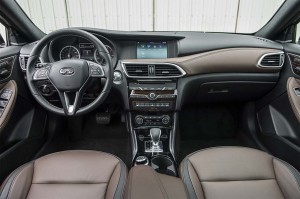
The interior features a different layout than the Mercedes GLA, especially shifter and display screen.
The Sport model is about 111 pounds lighter than the QX30 Premium model, and carries 13.2 gallons of fuel versus 14.8 gallons in the AWD Premium model. The extra fuel capacity is needed with AWD trims, as they exact a 3 mpg penalty in the city and on the highway versus FWD models (21/30 FWD — 24/33 AWD).
There are three trim levels available. The base QX30 is available in Front-Wheel Drive guise only, while Luxury and Premium models are available with FWD or All-Wheel Drive. The QX30 Sport is only available with FWD. QX30 prices range from $29,950 (Base) to $38,500 (Sport).
As far as luxury and convenience go, the QX30 is well equipped with a raft of standard and available features. The seven-inch telematics screen offers monitoring of Bluetooth phone and audio streaming, and controls a full suite of standard and available apps, including Infiniti’s proprietary “InTouch” system which integrates navigation, convenience, security and entertainment into a dash-mounted state-of-the-art system.
One very slick feature is the “Gallery White” interior option. Pure white leather seating with red contrast stitching provides a dynamic, ultra luxury look, and a feeling the QX30 costs substantially more than its very reasonable price points.
On the high-tech front, Infiniti is, as usual, at the top of its game. I recall an incident more than 15 years ago in an Infiniti Q45. The “Q” was equipped with a then rare backup camera, and I was able to swiftly back into a tight space in the middle aisle of a three-pump gas station.
The woman in the car behind me, already filling her car, noticed I did not turn around when backing and violently beat on the back of the Q45 in an effort to get me to stop. “I see you,” was my harried and angry response, as I pointed out the crystal clear dashboard rear camera view with assist lines
In the 2017 QX30, standard and available tech abounds. Infiniti’s new available Intelligent Park Assist uses 12 sensors to determine if a potential parking spot is the right size. If it is, you simply move the gearshift lever to “R,” press a button to confirm, and operate the accelerator and brake pedals. The QX30 will park itself smoothly in parallel or reverse-in parking spots.
The optional Around View Monitor with Moving Object Detection and Front and Rear Sonar System uses four cameras build a virtual 360° bird’s eye view on the 7” telematics display to help you see what’s around you and Moving Object Detection alerts you to objects moving in the display image, like the little neighborhood kid on a tricycle.
The available Forward Emergency Braking system adds another dimension of security. It can detect vehicles in the lane ahead of you, and if deceleration is required, the brakes are applied to help minimize/prevent a collision.
Infiniti’s parent, Nissan, has been ramping up a global alliance with Mercedes parent Daimler AG. That effort is yielding a variety of benefits, they claim, from lower purchasing costs to shared powertrains and, now, joint vehicle projects.
The 2017 QX30 is a well-executed collaboration between these automotive titans. I’m looking forward to the next model in the Nissan (Infiniti)/Mercedes-Benz plan.
(Mercedes reveals AMG E63 ahead of LA debut. Click Here to check it out.)

